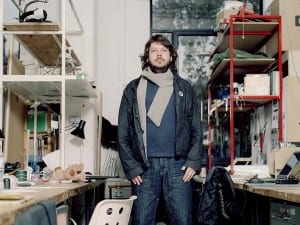Calvert 22 is a not for profit foundation that focuses its attention on exposing visitors to contemporary art from Russia and Eastern Europe. Promoting an understanding and exposure, the gallery hopes to generate excitement and interest in this rapidly developing art scene. These artists offer a fresh perspective, having studied on a global level and incorporating the canon of Western art as well as an examination of their own cultural identity and heritage, their work speaks to every viewer in a personal way.
The current show, The Practice For Everyday Life, frames the work of eight young Russian artists who employ a variety of medias. The title for the exhibition draws its name from the seminal text by theorist Michel de Certeau. In this text Certeau combined various theories to understand how mass culture appropriates and consumes all aspects of everyday life to create their own understanding. Both appropriate and playful in connotation, the title conveys both a defining element for each piece, as well as a direction and sense of ongoing development and experimentation. Ranging from social critiquing films to books sculpted into architectonic forms, these artists are truly engaging in a fascinating critique on the current status of society. Each piece deals with a different aspect of life and values, speaking to a cross-cultural audience: despite gender, nationality or personal convictions, the show promotes discussion and introspection through a variety of mediums.
An extremely poignant video installation by the artist Taus Makhacheva, entitled Rehlen (avar language flock) (2009), shows a young man wearing a traditional sheepskin coat, the traditional attire of shepherds, scrambling towards a herd of sheep and attempting to join their flock. Upon first glance, the sheep are quite easily discernible and identifiable, but when watching further, your eye adjusts and there is a gargantuan mass covered in sheepskin lumbering around with the flock. After watching for a while, it becomes easy to distinguish a man literally in sheep’s clothing. What Makhacheva is critiquing is the loss of community in modern society. Isolated by the technological advancements of our contemporary world, we have lost all sense of community and interaction. We live in large cities, surround ourselves with people everyday, but a sense of isolation still exists. People will do anything to fit into and find a place within the world they so long to belong to and this experiment of man and flock of sheep also illustrates the limits and extremes that people will go to so as to find a place within a community setting that offers security and support. All through videos poignantly critique current relationships to the environment, identity and culture.
The paintings of interior spaces by Yulia Ivashkina appear to be a snapshot of someone’s home and personal space that has just been vacated. There is a haunting presence of someone just gone; a missing or unseen presence haunts the limits of the canvas. There is a profound sense of voyeurism that permeates the painting but also a recognizable feeling of human indifference and a sense of isolation that has been crafted by the technological world we exist in.
In a series of works by Sergey Ogurtsov entitled Empty Homes of Being, (2008-10) the artist has taken key texts by influential writers such as Antonin Artaud and Gaston Bachelard, opened the book to the middle and folded the pages into intricate, architectonic sculptures. By taking books of such an iconic status and recreating them into small, pristine sculptures, Ogurtsov is forcing the viewer to evaluate the importance we place on such texts. As a society that focuses more on popular culture than revisiting our past and understanding it, we look at as something of beauty and a text that makes one sound intellectual to quote without really knowing the context.
The exhibition as a whole is one cohesive show that, upon leaving, resonates and allows for questions and an introspective look at the self and society. Although the artist’s are all Russian, and that is ever present in their work, there is also a sense of universality. Everyone, despite associations can understand, comprehend and find a deeper sense of introspection, share a laugh and see some truly inspired art by some talented young artists.
Practice For Everyday Life – Young Artists From Russia continues at Calvert 22 until 29 May. Visit the website for further information and curator essays.
Aesthetica Magazine
We hope you enjoying reading the Aesthetica Blog, if you want to explore more of the best in contemporary arts and culture you should read us in print too. In the spirit of celebration, Issue 40 includes features on James Turrell, Wim Wenders, sculptors Alice Anderson and Kate MccGwire plus an extended feature on the Making is Thinking show at Witte De With Center for Contemporary Art in Rotterdam. You can buy it today by calling +44(0)1904 479 168. Even better, subscribe to Aesthetica and save 20%. Go on, enjoy!
Image: Tanya Akhmetgalieva
The chrysalis phase (2009)
Courtesy the artist and Calvert 22





